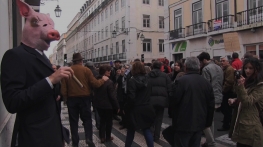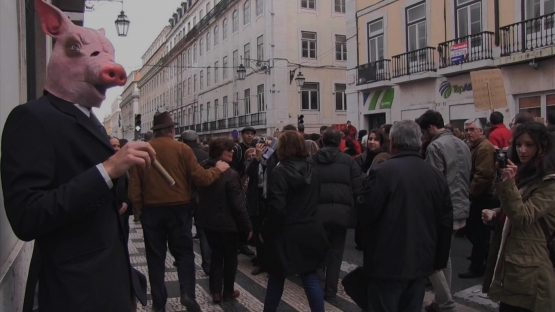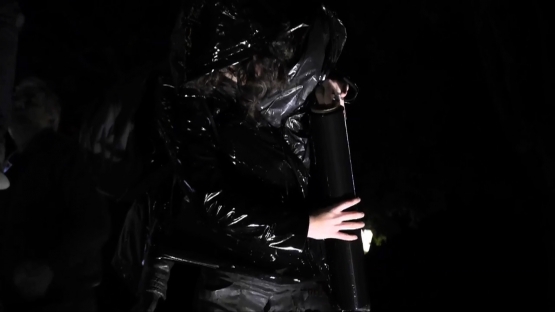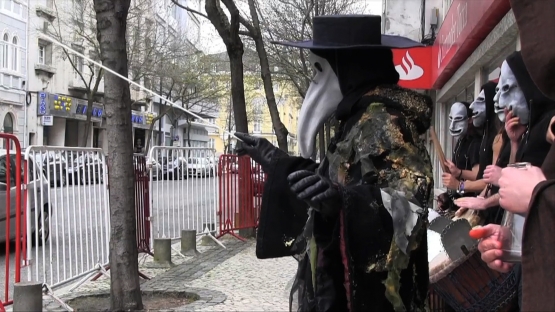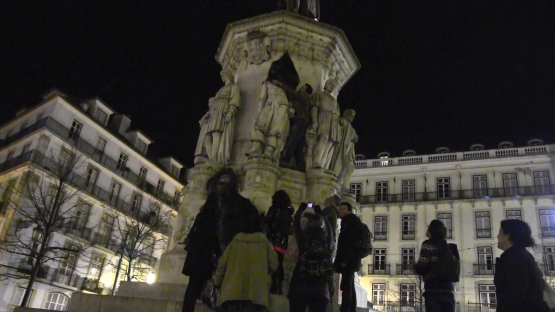Rui Mourão
Our Dreams Don’t Fit in Their Ballot Boxes!
This piece by Rui Mourão was created between 2012 and 2014, and is an audio and video record of performances by activists from the so-called “new social movements” in response to the economic, political and social crisis and Troika’s intervention in Portugal.
The work shown here consists of 5 multimedia projections of 10 performances that the artist selected from dozens, and of audio recordings made from 5 listening points that include statements from the participants and authors of these “artivist” performances relating their ideals, hopes and aims.
The artist closely monitored several of these activists, who have independent strategies and a strong belief in art’s social and political role. Since 2008, in response to the recent global economic crisis, this “artivistic” approach has been taken up world-wide with the Occupy movements, and has become a new element in the social and political fabric of Western democracy, which is seeing its modes of representation increasingly challenged.
Rui Mourão took on a “participatory collaboration”, which closely ties his work with the relationships that contemporary art has forged with anthropology and ethnography, as models that are able to analyse the aesthetic exploration of reality more effectively and thoroughly.
In a country in which democracy has become a non-participative concept hindering the exercise of citizenship, the role of collaborative art as seen here has become crucial. Museums also need to make use of the artist as a producer and need to be able to critically analyse the role that they play in legitimising artists.
This piece is also a resilient option to the dictates of the art system, which expects artists to be rebellious and subversive, but not inspire critical debate or reflection.
Rui Mourão is clearly among the new generation of artists who are conscious of social and political dynamics and are keen to lessen the gap between art and the world, thus recuperating a utopia that underlies artistic discourse, one in which art can contribute to its very transformation.
Emília Tavares
Curator
Multimedia Installation
Statues in Mourning / in Struggle
During the official visit by Chancellor Angela Merkel to Portugal (12/11/2012), the Que se Lixe a Troika (Screw the Troika) group covered dozens of public statues throughout the country with black sashes. According to the collective’s press release, this form of protest was designed “not as a sign of mourning, but of struggle against the troika, in defence of democracy and our rights”.
Images: Rui Mourão
Essay on Unemployment
An action carried out by unemployed people at a social security office in Areeiro, in Lisbon (30/09/2010) as part of a Theatre of the Oppressed workshop, using Augusto Boal’s “invisible theatre” method. Complaining about the waiting time, the absurdity of certain bureaucratic procedures and the inadequacy of the office’s facilities for so many unemployed people, the performers managed to gain the support of other unemployed people in the room, creating an enormous improvised mass of protestors.
Taken from the internet blog "Ensaio sobre o
Desemprego" (authors: participants in the action with hidden cameras,
names are not given in the video).
We Are All Captains
A happening created by Colectivo Negativo outside the Assembly of the Republic (30/10/2012) in which toy soldiers metaphorically lay siege to parliament. Passersby were invited to take part in the artivist performance, helping to set up an installation of thousands of tiny plastic soldiers next to the security barriers, with their guns trained on parliament. Simultaneously, a recording was played of interviews in which children discussed their dreams for the future.
Images provided by Colectivo Negativo.
The Plague – Urbi et Orbi
Another Colectivo Negativo happening, this time outside the Ministry of Health (08/04/2013) in defence of the national health system. The action against the budget cuts in this area, along with a declining quality of service and increased patient charges, was a collaboration with the Slap – hand to hand percussion group. It consisted of an allegorical haunting of the Ministry of Health by medieval Danse Macabre figures and the Plague Doctor, who read out a text adapted from Antonin Artaud’s “The Theatre and the Plague”.
Images: Rui Mourão
Capitalist Pig at the Demonstration
A man dressed in a suit and tie put on a pig’s head disguise and positioned himself outside a bank on the Rua do Ouro which he knew was on the route of a large demonstration taking place that day in Lisbon (02/03/2013). When the demonstrators passed by the bank, this cigar-toting figure made snobbish gestures to shoo them away from “his” bank. For several hours, this arrogant anthropomorphised pig provocatively caricatured the exclusionary economic and financial model.
Images: Rui Mourão
Luxury in the Metro
This artivist performance took place in Lisbon’s metro (22/06/2012) and was an initiative by the Indignados Lisboa movement in protest at the repeated substantial increases in public transport fares over a short period of time. Participants dressed up as “rich people” and wandered around the stations and carriages in festive mood, socialising, dancing and drinking fake champagne. Using a humorous and ironic agitprop technique, they argued that the price rise would turn the metro into something exclusive rather than inclusive, creating a caricature in which the service could only be used by the rich.
Images provided by one of the
participants in the action who does not wish to be identified
Grândola Interrupts a Parliamentary Session
This action by the Que se Lixe a Troika movement, a disruption of the parliamentary status quo during a speech by Prime Minister Passos Coelho (15/02/2013), was the artivist performance that received greatest media coverage and had the biggest national impact. It was a total surprise when people sitting in the public galleries stood up and filled the “House of the People” with the refrain “it is the people who lead”. As this powerful song (symbol of the legendary revolution) echoed through the seat of government, directed by the electorate at their political representatives, it created a scene of ideological conflict which placed the prime minister in the metaphorical role of opponent of the values of the 25 April revolution, drawing him into the performance by turning him into an involuntary performer in the action.
Taken from the internet, on YouTube (producer: Canal Parlamento).
Subversive Song at the 5 October Celebrations
When the annual celebrations of the establishment of the Republic took place in a place without public access – the Pátio da Galé (05/10/2012) – with the regime withdrawing into itself, an opera singer infiltrated herself, singing a historic song of resistance against the Estado Novo dictatorship: "Firmeza" (“Strength”) by Fernando Lopes-Graça. Expressed through a musical interpretation which, like the “Grândola" performance in parliament, was a symbol of opposition, there was a very interesting difference about this artivist performance. It demonstrated that just one person – even when operating outside collectives or the political apparatus of parties, unions, employers’ associations or governments – can be much more powerful and capable of intervention in the public sphere than is generally believed. For this to happen it is crucial that the message is delivered as a surprise element, in a space and/or time that are meaningful, that it has an emotional dimension and that it is disseminated in the media and/or internet.
Taken from the internet, on YouTube (producer: Económico TV).
Dumbledore’s Army in the Metro
Subvertising action carried out on Lisbon’s metro by the Exército de Dumbledore (Dumbledore’s Army) collective, in opposition to the current political and economic system, during Angela Merkel’s visit to Portugal (12/11/2012). Subvertising is a concept which refers to the subversion of advertising on panels or billboards, in which the original brand message is altered or replaced with another message, in a creative act of anti-capitalist hijacking.
Taken from the internet, on YouTube (authors: the participants in the
action, names are not given in the video).
Flag Exchange in City Hall
A man in a Darth Vader mask (the notorious villain of the “Star Wars” film saga) climbed up a ladder at night to the balcony of Lisbon’s town hall, took down the usual flag and raised the flag of the monarchy (10/08/2009). This bizarre and humorous act stripped a symbol of the Republic of its sacrosanct power, in a reversal of the famous gesture which took place in that location (the raising of the flag of the Republic during the 1910
revolution). A video recording was made of the performance and posted on the internet, and the right-wing political group 31 da Armada claimed responsibility. It can thus be seen that, despite being predominantly a tool of the left, artivist performances are – regardless of their ideological stance – a medium of subversive opposition which enable anyone with the motivation to become a political actor within the public sphere and contribute to the exercise of democracy.
Taken from the internet blog "31 da Armada" (artists: the participants in the action, names are not given in the video).
Headphones # 1
(duration: 43:18)
Interviewee: Ana Maria Pinto, 32, opera singer, founder of the Coro de Intervenção (Intervention Choir) of Porto; participant in 1 of the 10 artivist performances whose images are part of the video installation (“Subversive Song at the 5 October Celebrations”).
Interview conducted in: September 2013.
Place of interview / soundscape: Cais do Sodré metro station.
Interviewee: Henreles Henrique, 26, visual and performing artist, studying for a masters in theatre directing, founding member of Colectivo Negativo; participant in 2 of the 10 artivist performances whose images are part of the video installation (“We Are All Captains” and “Of the Plague – Urbi et Orbi”).
Interview conducted in: March 2013.
Place of interview / soundscape: a corner cafe popular with young people next to the Ministry of Health.
Interviewee: Joana Freches Duque, 23, actor, studying choreographic research and composition, a founding member of Colectivo Negativo; participant in 2 of the 10 artivist performances whose images are part of the video installation (“We Are All Captains” and “The Plague – Urbi et Orbi”).
Interview conducted in: March 2013.
Place of interview / soundscape: a corner cafe popular with young people next to the Ministry of Health.
Headphones # 2
(duration: 01:11:58)
Interviewee: Duarte Guerreiro, 27, Fine Arts graduate, unemployed, regular collaborator with various groups / individual activists. He filmed 1 of the 10 artivist performances whose images are part of the video installation (information withheld).
Interview conducted in: January 2013.
Place of interview / soundscape: Clube Estefânia, during a Livestream workshop.
Interviewee: Lídia Fernandes, 39, research fellow at FCT in Labour Relations, Social Inequality and Trade Unionism, an activist involved with feminist, antiracist and housing rights movements, such as UMAR, the World March of Women and Habita, and a Left Block (BE) activist; participant in 1 of the 10 artivist performances whose images are part of the video installation (“Essay on Unemployment”).
Interview conducted in: October 2013.
Place of interview / soundscape: ISCTE (University Institute of Lisbon) campus.
Headphones # 3
(duration: 01:15:23)
Interviewee: Pedro Feijó, 21, university student studying general studies – a joint course run by the Fine Arts, Sciences and Arts Faculties, he has collaborated regularly with various groups / individual activists; participant in 1 of the 10 artivist performances whose images are part of the video installation (information withheld).
Interview conducted on: September 2013.
Place of interview / soundscape: Foyer of São Jorge Cinema.
Headphone # 4
(duration: 01:19:21)
Interviewee: Ricardo Castelo Branco, 46, unemployed, graduate in Portuguese and French language and literature, founding member of A Luta, he regularly collaborates with other groups / individual activists; participant in 2 of the 10 artivist performances whose images are part of the video installation (“Luxury in the Metro” and “Grândola Interrupts a Parliamentary Session”).
Interview conducted in: October 2013.
Place of interview / soundscape: steps to Pensão Amor bar.
Interviewee: Rodrigo Moita de Deus, 36, business communication consultant, founding member of the 31 da Armada blog, royalist, member of the national policy committee of the PSD; participant in 1 of the 10 artivist performances whose images are part of the video installation (“Flag Exchange in Paços do Concelho“).
Interview conducted in: September 2013.
Place of interview / soundscape: a company office.
Headphones # 5
(duration: 01:20:45)
Interviewee: João Pestana, 56, aeronautical communication and information specialist, founding member of Indignados Lisboa, founding member of the Algés Popular Assembly, an active member of the Rossio Protest Camp in 2011; participant in 1 of the 10 artivist performances whose images are part of the video installation (“Luxury in the Metro”).
Interview conducted in: October 2013
Place of interview / soundscape: Praça do Rossio
Interviewee: Joana Manuel, 37, actor, member of the Que se Lixe a Troika collective, she has collaborated regularly with other groups / individual activists; participant in 1 of the 10 artivist performances whose images are part of the video installation (“Grândola Interrupts a Parliamentary Session”).
Interview conducted in: September 2013.
Place of interview / soundscape: outside the National Assembly of the Republic.

